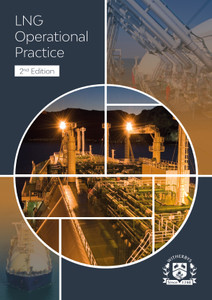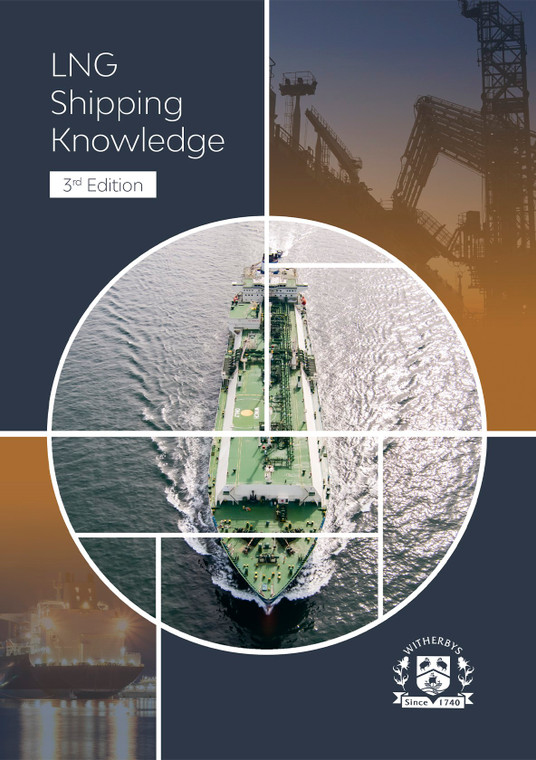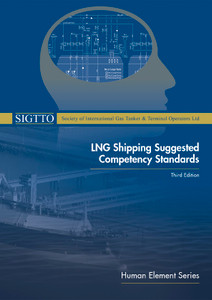
This publication details the underpinning knowledge required for ship’s officers serving on LNG carriers, as set out in SIGTTO’s ‘LNG Shipping Competency Standards’. It has been updated to reflect the substantial technical and operational advances on LNG carriers since publication of the 2nd edition.
With the rapid growth of LNG shipping, the introduction of a system of internationally recognised and structured training programmes was necessary. In 2005, the Society of International Gas Tanker and Terminal Operators (SIGTTO) released the first version of its ‘LNG Shipping Competency Standards’ to provide guidance and suggested best practice for the industry. A second edition was published in 2008. This third edition was published in 2020 to incorporate developments within the LNG industry, including the latest updates to The International Code for Construction and Equipment of Ships Carrying Liquefied Gases in Bulk (IGC Code).
At almost 500 pages, this publication covers all areas of LNG carriage and care by sea.
Transportation of LNG by sea commenced in 1958 when the ‘Methane Pioneer’ carried 5,000 m3 of LNG from the USA to the UK. Since then, particularly in the 21st century, LNG shipping has grown rapidly.
To put this level of advance in context, in 2006, the world fleet of LNG carriers was over 200 ships. At the beginning of 2020 there were 540 LNG carriers in service, with over 130 LNG carriers on order. In 2019, LNG carriers carried out 5,701 trade voyages.
Over the last 60 years, the size, capacity and complexity of LNG carriers has increased significantly. In addition, the technology has continued to evolve in respect of propulsion plants and cargo management systems. The commercial nature of LNG shipping has also evolved, as LNG is increasingly traded and used as an energy source around the world. Initially, LNG carriers were dedicated to a specific project, however, LNG operations have now developed into long term and spot charters.
With the rapid growth of LNG shipping, the introduction of a system of internationally recognised and structured training programmes was necessary. In 2005, the Society of International Gas Tanker and Terminal Operators (SIGTTO) released the first version of its ‘LNG Shipping Competency Standards’ to provide guidance and suggested best practice for the industry. A second edition was published in 2008. This third edition was published in 2020 to incorporate developments within the LNG industry, including the latest updates to The International Code for Construction and Equipment of Ships Carrying Liquefied Gases in Bulk (IGC Code).
The SIGTTO ‘LNG Shipping Competency Standards’ summarise the minimum tasks and knowledge considered necessary, relative to the area of individual responsibility. This publication, ‘LNG Shipping Knowledge’, follows that format, providing the underpinning knowledge meeting the recommendations of the third edition of the ‘LNG Shipping Competency Standards’. This makes this publication a powerful and useful support tool for understanding modern LNG shipping.
During the course of the construction of this publication, technical expertise has been sought across many professional sources.
As LNG shipping possesses an excellent safety record, with very few incidents compared to similar segments of the shipping industry, it is essential that companies and individuals continue to invest in training to enhance and improve their knowledge and awareness of LNG shipping.
Acknowledgements
Introduction
1
LNG
Fundamental
Knowledge
and
Understanding
1.1
Physics
and
Chemistry
1.2
Principles
of
Design
1.3
Regulations
and
Guidance
1.4
Principles
of
Tank
Atmospheres
1.5
Properties
of
Materials
1.6
Hazards
of
LNG
and
Relevant
Gases
1.7
Environmental
Impact
1.8
Risk
Assessment
1.9
Individual
Responsibilities
1.10
Contingency
Plans
1.11
Record
Keeping
1.12
Planning
2
LNG
Equipment
2.1
Cargo
System
–
Tank
Construction
2.2
Air
and
Inert
Gas
Driers
2.3
Inert
Gas
Generator
2.4
Nitrogen
Systems
2.5
LNG
Vaporiser
2.6
High
Duty
Compressor(s)
2.7
Low
Duty
Compressor(s)
2.8
Gas
Heaters
2.9
Forcing
Vaporiser
2.10
Cargo
Pumps
2.11
Spray
Pumps
2.12
Cargo
Tank
Protection
Devices
2.13
Cargo
Line
Protection
Devices
2.14
Cargo
Space
Protection
Devices
2.15
Cargo
Liquid
and
Vapour
Valves
2.16
Cargo
Tank
Protection
System
2.17
Reliquefaction
Plant
(if
fitted)
2.18
Gas
Combustion
Unit
(Oxidiser)
2.19
Regasification
Plant
2.20
Cargo
Related
Spaces
3
LNG
Support
Systems
3.1
Nitrogen
Pressurisation
and
Purge
3.2
Cofferdam
Heating
System
3.3
Fixed
Gas
Detection
3.4
Portable
Gas
Detection
Equipment
3.5
Emergency
Shutdown
System
(ESDS)
3.6
Emergency
Mooring
Release
3.7
Water
Curtain
3.8
Drenching
System
3.9
Fixed
Dry
Powder
Installations
3.10
Level
Gauging
Systems
3.11
Custody
Transfer
Measurement
System
(CTMS)
3.12
Certified
Safe
Electrical
Equipment
3.13
High
Voltage
Systems
3.14
IAS
System
3.15
Turbo
Alternator
Control
Systems
3.16
Propulsion
Types
3.17
Gas
Combustion
Systems
4
LNG
Standard
Operations
4.1
Cargo
Tank
Cleaning
4.2
Hold
Space
and
Cargo
Tank
Drying
4.3
Nitrogen
Purging
of
Containment
System
4.4
Inerting
of
Cargo
System
4.5
Ship
and
Shore
Preparation
and
Manifold
Connection
4.6
Gassing
Up
(Purging)
of
Cargo
System
4.7
Cooldown
of
Cargo
System
4.8
Loading
4.9
Loaded
and
Ballast
Passage
4.10
Discharging
4.11
Warm-Up
4.12
Gas
Freeing
4.13
Aeration
4.14
Ship
to
Ship
(STS)
Preparation
and
Manifold
Connection
4.15
Ship
to
Ship
Transfer
of
Cargo
5
LNG
Non-Standard
and
Emergency
Operations
5.1
Types
of
Non-Standard
and
Emergency
Operations
5.2
Multiple
Cargo
Pump
Failure
in
One
Tank
5.3
Gas
Freeing
a
Single
Tank
5.4
Part
Load
and
Discharge
5.5
Non-Availability
of
Key
Equipment
5.6
Loss
of
Gas
Handling
Capability
5.7
Prolonged
Loss
of
Power
to
Cargo
and
Ancillary
Systems
5.8
Loss
of
Primary
Containment
5.9
Ballast
Tank
Leakage
into
Containment
Space
5.10
Nitrogen
Supply
Failure
5.11
Jettison
of
Cargo
5.12
Overfilling
of
a
Cargo
Tank
5.13
Loss
of
Cargo
Pipeline
Containment
5.14
Failure
of
Integrated
Automation
System
5.15
Uncontrolled
Release
of
Cargo
6
LNG
Commercial
Considerations
6.1
Terms
and
Conditions
in
Use
446
6.2
Vetting
and
Inspection
Processes
6.3
Ship/Shore
Compatibility
Assessment
Annex
I
–
Reference
Documents
Annex
II
–
Definitions
Witherbys
Witherbys titles are developed using scripts developed by technical experts that are peer reviewed within work groups. Typically, they seek to improve understanding of the regulations, recommendations and guidelines issued by Industry.
Witherbys staff have significant expertise in the fields of navigation and hazardous cargoes as well as in the presentation of complex subjects in a graphic and easy to understand manner.
- Number of Pages:
- 467
- ISBN:
- 9781856099035
- Binding Format:
- Hardback
- Book Height:
- 304 mm
- Book Width:
- 218 mm
- Weight:
- 2.4 kg
- Author:
Witherby Publishing Group
- Published Date:
- July 2020
- Preview:
- Yes
- Product Catalogue:
- Definitive Guides PDF






